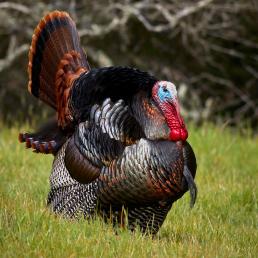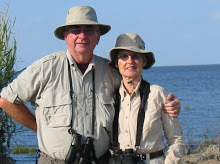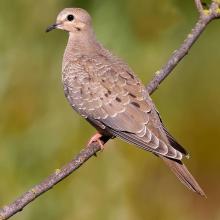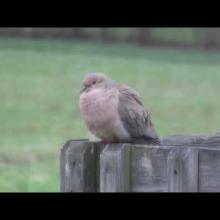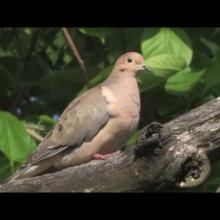

Join BirdNote tomorrow, November 30th!
Illustrator David Sibley and actor H. Jon Benjamin will face off in the bird illustration battle of the century during BirdNote's Year-end Celebration and Auction!
Many species of birds nest in shelterbelts — also known as windbreaks — parallel rows of trees and shrubs planted to shelter houses, farms, and livestock from strong winds and drifting snow. Because shelterbelts often provide more food and lack the predators found in woodlands, they are great places for birds. In a North Dakota study, Brown Thrashers, like the one pictured here, had higher nesting success than their fellow woodland birds. With incentives provided to farmers by the federal Conservation Reserve Program, millions of trees are still being planted for wildlife.
Support for BirdNote comes from American Bird Conservancy and Bringing Back the Birds, a photo book by Owen Deutsch on the importance of protecting birdscapes. Available at amazon.com.
BirdNote®
Shelterbelts and Their Birds
Written by Dennis Paulson
This is BirdNote!
[Mourning Dove cooing]
A Mourning Dove calls from a shelterbelt on a hot North Dakota afternoon. Shelterbelts – also known as windbreaks – are parallel rows of trees and shrubs planted to shelter houses, farms and livestock from strong winds and drifting snow. [wind]
In 1934, Franklin D. Roosevelt established the Great Shelterbelt Project to alleviate dust storms on the Great Plains. By 1942, 220 million trees had been planted from the Canadian border to Texas. Planted for people, they gave immediate value to birds and other wildlife. [Orchard Oriole song]
Like this Orchard Oriole, many of our common woodland birds nest in shelterbelts. These corridors of trees often provide more food and nest sites and lack the predators found in solid stands of woodland, so they are great places for birds to live. [Brown Thrasher song]
In a North Dakota study, Brown Thrashers in shelterbelts had higher nesting success than their fellow birds in woodlands. With incentives provided to farmers by the federal Conservation Reserve Program, millions of trees are still being planted for wildlife. [bring in wind again]
For BirdNote, I’m Mary McCann. Support for BirdNote comes from American Bird Conservancy and Bringing Back the Birds, a photo book by Owen Deutsch on the importance of protecting birdscapes. Available at amazon.com.
###
Bird sounds provided by The Macaulay Library of Natural Sounds at the Cornell Lab of Ornithology, Ithaca, New York. Call of Mourning Dove [22980] recorded by W.R. Fish; song of Orchard Oriole [40765] by G.Budney; song of Brown Thrasher [94281] by W.L. Hershberger.
Wind [Nature SFX 01] recorded by Gordon Hempton of QuietPlanet.com.
BirdNote’s theme music was composed and played by Nancy Rumbel and John Kessler.
Producer: John Kessler
Executive Producer: Chris Peterson
© 2015 Tune In to Nature.org August 2017/2020 Narrator: Mary McCann
ID# shelterbelt-01-2013-08-17 shelterbelt-01
